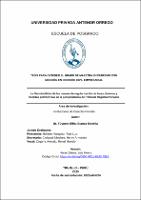La Derrotabilidad de las normas de regularización de áreas, linderos y medidas perimétricas en la jurisprudencia del Tribunal Registral Peruano

Ver/
Descargar
(application/pdf: 1.292Mb)
(application/pdf: 1.292Mb)
Fecha
2023Autor(es)
Túyume Effio, Blanca Estrella
Metadatos
Mostrar el registro completo del ítemResumen
La presente investigación está referida al análisis de la aplicación del criterio de derrotabilidad en las resoluciones del Tribunal Registral Peruano en materia de regularización de áreas, linderos y medidas perimétricas; cuyos mecanismos de saneamiento se encuentran regulados en la Ley N° 27333.
Es por ello que se ha formulado el siguiente problema: ¿Por qué en algunas resoluciones de la jurisprudencia del Tribunal Registral Peruano sobre la regularización de áreas, linderos y medidas perimétricas aparece el criterio de derrotabilidad y en otras no? Para obtener una hipótesis al problema planteado, se ha profundizado en un estudio doctrinario y jurisprudencial que coadyuve a comprender el concepto de derrotabilidad y su aplicación en las resoluciones del máximo ente administrativo.
En este sentido, el presente trabajo tiene como objetivos: i) Analizar por qué en algunas resoluciones de la jurisprudencia del Tribunal Registral Peruano sobre la regularización de áreas, linderos y medidas perimétricas aparece el criterio de derrotabilidad y en otras no; ii) Delimitar la derrotabilidad para comprender su contribución en la aplicación de las normas de regularización de áreas, linderos y medidas perimétricas; iii) Describir el tratamiento jurídico de la normatividad aplicable a la regularización de áreas, linderos y medidas perimétricas; y iv) Examinar la jurisprudencia más resaltante del Tribunal Registral Peruano emitidas durante el periodo 2006 a 2020 en materia de regularización de áreas, linderos y medidas perimétricas, a fin de vislumbrar la aplicación del criterio de derrotabilidad.
Finalmente, la investigación se diseña bajo el método cualitativo no experimental basado en el estudio de caso que parte del análisis y recolección de datos de las resoluciones más resaltantes emitidas por el Tribunal Registral durante el periodo del año 2006 al año 2020 en materia de regularización de áreas, linderos y medidas perimétricas, teniendo como resultado que el máximo ente administrativo desconoce el criterio de derrotabilidad y resuelve los casos sin tener conciencia de ello, lo que se traduce en la falta de uniformidad en sus decisiones. The present investigation is referred to the analysis of the application of the criterion of defeatability in the resolutions of the Peruvian Registry Court in matters of regularization of areas, boundaries and perimeter measures; whose sanitation mechanisms are regulated by Law No. 27333.
That is why the following problem has been formulated: Why in some resolutions of the jurisprudence of the Peruvian Registry Court on the regularization of areas, boundaries and perimeter measures does the defeatability criterion appear and in others it does not? To obtain a hypothesis to the problem posed, a doctrinal and jurisprudential study has been deepened in order to help understand the concept of defeatability and its application in the resolutions of the highest administrative entity.
In this sense, the present work aims to: i) Analyze why in some resolutions of the jurisprudence of the Peruvian Registry Court on the regularization of areas, boundaries and perimeter measures the criterion of defeasibility appears and in others it does not; ii) Delimit the defeasibility to understand its contribution in the application of the norms of regularization of areas, boundaries and perimeter measures; iii) Describe the legal treatment of the regulations applicable to the regularization of areas, boundaries and perimeter measures; and iv) Examine the most outstanding jurisprudence of the Peruvian Registry Court issued during the period 2006 to 2020 regarding the regularization of areas, boundaries and perimeter measures, in order to glimpse the application of the defeasibility criterion.
Finally, the research is designed under the non-experimental qualitative method based on the case study and text analysis, starting from the analysis and data collection of the set of resolutions issued by the Registry Court during the period from 2006 to 2020 in matter of regularization of areas, boundaries and perimeter measures, with the result that the highest administrative entity ignores the criterion of defeatability and resolves cases without being aware of it, which translates into a lack of uniformity in its decisions.

